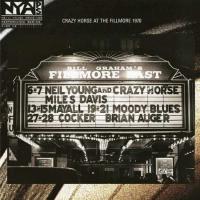Crazy Horse Live 1970 Well Worth the Wait!
Memories can play nasty tricks on the mind. Events long since past that once seemed sublime can turn out to be anything but when the time machine slides them into the present.
This eagerly awaited, recently unearthed time capsule will surpass your highest expectations. If you’re of a certain age, it will take you back to that time. If you’re not, it will let you catch a glimpse of when grunge was invented without anyone, including the inventors, knowing about it.
Crazy Horse members Danny Whitten (guitar), Billy Talbot (bass) and Ralph Molina (drums) were already a tight unit known as The Rockets when Young met them in an L.A. club shortly after the break-up of The Buffalo Springfield and the release of his eponymous solo debut. The legendary Jack Nitzsche had worked with Young on the sublime “Expecting to Fly” and was more than sympathetic to the cause.
Crazy Horse had backed Young on the then recently released, now classic Everybody Knows This Is Nowhere, which contained, in addition to the title song, “Cowgirl in the Sand,” “Cinnamon Girl” and of course “Down by the River” gritty, gripping songs that have only increased in stature over time.
Young and the late Whitten (the subject of “The Needle and the Damage Done,” and written before his death at age 29 two years after this was recorded and whose death Young once felt was partially his fault), produce precision dueling guitar pyrotechnics throughout.
Despite the flawed reputation of many great rock acts of the time when it came time to playing live, Neil Young, ever the perfectionist and Crazy Horse, were a tightly meshed ensemble, thanks in part to Ralph Molina’s stellar, deliberate time keeping. You can spend your time listening to his cymbal hits and nothing else and it would be time well spent, especially since the recording of them is so clean, clear and well focused.
The mix places the guitars stage right and left with the drums and bass centered, making every element easy to spot and enjoy. Whatever Nitzsche Crank it up and you’re standing in front of the Fillmore East stage. Neil Young and Crazy Horse, plus Miles Davis, with The Steve Miller Band as the opener? Now that was crazy, adventurous triple act booking!
The gatefold packaging is first rate, using a nice-to-the-touch paper stock that makes for a perfect fit on the shelf next to all of your original Neil Young albums.
The insert credits John Nowland with the “Analog to digital Transfers” at Young’s Redwood Digital and the mixing and mastering at Redwood Digital by Tim Mulligan, but it’s unclear whether that was after a mixdown to two track analog or whether the multitrack was mixed down to digital. However, the sound makes it clear that either the lacquer was cut from an AAA master tape, or Young’s high resolution (192/24 bit) digital chain is super-clean, ultra-transparent and where the hell can we all get what he’s got?
The 200 gram pressing is flat, perfectly quiet throughout and based on how it looks, not pressed at RTI. By that I mean that every pressing plant and/or brand of record press has particular physical properties that give away the source. In the case of this pressing, the outer lip trim is actually smoother and cleaner than RTI’s, while the record surface has slight “orange peeling” that will not affect playback or sound quality.
Given that early pressings from Classic’s second source (Bill Smith Records, in El Segundo, CA.) had rough edges, lots of noise and were pretty much a physical and sonic bust, this excellent pressing is very good news.
The fact is, if analog is to thrive and grow, we need more high quality pressing capacity in the world. RTI is booked solid and new orders face delays. Unless new presses go online, and soon, there will be no more growth. So if Classic has managed whip this plant into shape pressing 200 gram flat profile records, and based on this and other recent Classic issues, they have, that is good news all around!
As for this elpee, any Neil Young fan who doesn’t have or plan on buying Crazy Horse at the Fillmore 1970 isn’t really a Neil fan.
- Log in or register to post comments


